Biography
Giandomenico Facchina was born in 1826 in Sequals, today in the province of Pordenone in the Friuli Venezia Giulia region, at that time part of the Lombard-Venetian Kingdom. He was trained in Trieste and Venice. He first worked on the restoration of ancient mosaics, including the St Mark's Basilica in Venice. In the 1850s he traveled to France, first to Montpellier, where he was called to work on the restoration of old floors.
He filed a patent for a method of extracting ancient mosaic pavements at the National Institute of Industrial Property in 1858, reusing a technique already practiced by Venetian mosaic experts. He also used a derivative of this technique, which allows a prefabricated mosaic to be made in the workshop, facilitating production of the mosaic. In this technique, the mosaic tiles are pre-assembled and glued onto a flexible cardboard; the wall to hold the mosaic is then covered with fresh mortar and mosaic installed at once, reducing the working time on site and allowing a considerable reduction of production costs. This technique was used very successful at the Exposition Universelle (1855) in Paris and spread rapidly. It allowed Facchina get many orders. At Paris, he decorated, among others, the new opera house built by Charles Garnier.
Until his death in 1903 Giandomenico Facchina divided his time between his studios in Venice and Paris.

Veneto or Venetia is one of the 20 regions of Italy. Its population is about five million, ranking fourth in Italy. The region's capital is Venice while the biggest city is Verona.

The Palais Garnier, also known as Opéra Garnier, is a 1,979-seat opera house at the Place de l'Opéra in the 9th arrondissement of Paris, France. It was built for the Paris Opera from 1861 to 1875 at the behest of Emperor Napoleon III. Initially referred to as le nouvel Opéra de Paris, it soon became known as the Palais Garnier, "in acknowledgment of its extraordinary opulence" and the architect Charles Garnier's plans and designs, which are representative of the Napoleon III style. It was the primary theatre of the Paris Opera and its associated Paris Opera Ballet until 1989, when a new opera house, the Opéra Bastille, opened at the Place de la Bastille. The company now uses the Palais Garnier mainly for ballet. The theatre has been a monument historique of France since 1923.
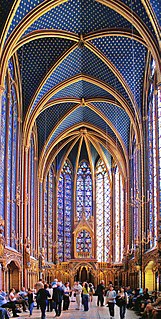
The Sainte-Chapelle is a royal chapel in the Gothic style, within the medieval Palais de la Cité, the residence of the Kings of France until the 14th century, on the Île de la Cité in the River Seine in Paris, France.
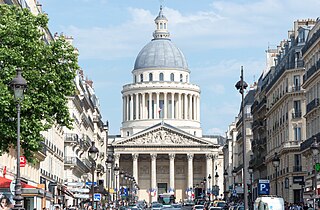
The 5th arrondissement of Paris is one of the 20 arrondissements of the capital city of France. In spoken French, this arrondissement is referred to as le cinquième.

The Patriarchal Cathedral Basilica of Saint Mark, commonly known as St Mark's Basilica, is the cathedral church of the Roman Catholic Patriarchate of Venice; it became the episcopal seat of the Patriarch of Venice in 1807, replacing the earlier cathedral of San Pietro di Castello. It is dedicated to Saint Mark the Evangelist, the patron saint of the city, and it holds his relics.

Giovanni Battista Tiepolo, also known as GiambattistaTiepolo, was an Italian painter and printmaker from the Republic of Venice who painted in the Rococo style, considered an important member of the 18th-century Venetian school. He was prolific, and worked not only in Italy, but also in Germany and Spain.
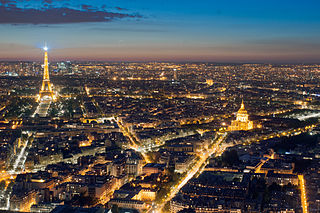
The 7th arrondissement of Paris is one of the 20 arrondissements of the capital city of France. In spoken French, this arrondissement is referred to as le septième.

Friuli is an area of Northeast Italy with its own particular cultural and historical identity containing 1,000,000 Friulians. It comprises the major part of the autonomous region Friuli Venezia Giulia, i.e. the administrative provinces of Udine, Pordenone, and Gorizia, excluding Trieste.
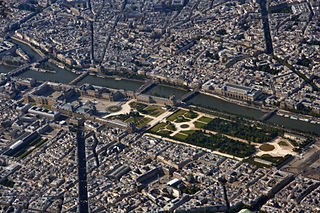
The 1st arrondissement of Paris is one of the 20 arrondissements of the capital city of France. In spoken French, this arrondissement is colloquially referred to as le premier. It is governed locally together with the 2nd, 3rd and 4th arrondissement, with which it forms the 1st sector of Paris (Paris-Centre).

Jean-Paul Riopelle, was a painter and sculptor from Quebec, Canada. He had one of the longest and most important international careers of the sixteen signatories of the Refus Global, the 1948 manifesto that announced the Quebecois artistic community's refusal of clericalism and provincialism. He is best known for his abstract painting style, in particular his "mosaic" works of the 1950s when he famously abandoned the paintbrush, using only a palette knife to apply paint to canvas, giving his works a distinctive sculptural quality. He became the first Canadian painter to attain widespread international recognition.

The Montagne Sainte-Geneviève is a hill overlooking the left Bank of the Seine in the 5th arrondissement of Paris. It was known to the ancient Romans as Mons Lucotitius. Atop the Montagne, are the Panthéon and the Bibliothèque Sainte-Geneviève, used by the students of the University of Paris. The side streets of the Montagne feature bars and restaurants, for example, in the Rue Mouffetard.

Ca' Rezzonico is a palazzo on the Grand Canal in the Dorsoduro sestiere of Venice, Italy. It is a particularly notable example of the 18th century Venetian baroque and rococo architecture and interior decoration, and displays paintings by the leading Venetian painters of the period, including Francesco Guardi and Giambattista Tiepolo. It is a public museum dedicated to 18th-century Venice and one of the 11 venues managed by the Fondazione Musei Civici di Venezia.

Giovanni Domenico Tiepolo was an Italian painter and printmaker in etching. He was the son of artist Giovanni Battista Tiepolo and elder brother of Lorenzo Baldissera Tiepolo.

Eugène Delaplanche was a French sculptor, born at Belleville (Seine).
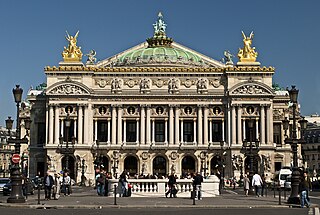
Second Empire style, also known as the Napoleon III style, was a highly eclectic style of architecture and decorative arts, which used elements of many different historical styles, and also made innovative use of modern materials, such as iron frameworks and glass skylights. It flourished during the reign of Emperor Napoleon III in France (1852–1871) and had an important influence on architecture and decoration in the rest of Europe and North America. Major examples of the style include the Opéra Garnier (1862–1871) in Paris by Charles Garnier, the Bibliothèque nationale de France, the Church of Saint Augustine (1860–1871), and the Philadelphia City Hall. The architectural style was closely connected with Haussmann's renovation of Paris carried out during the Second Empire; the new buildings, such as the Opéra, were intended as the focal points of the new boulevards.

Pauly & C. - Compagnia Venezia Murano is one of the most ancient glass factory of Murano: it was founded more than 150 years ago. This company produces glass art, most notably Roman murrine, mosaics and chandeliers.
This article presents the main landmarks in the city of Paris within administrative limits, divided by its 20 arrondissements. Landmarks located in the suburbs of Paris, outside of its administrative limits, while within the metropolitan area are not included in this article.

Philippe Chaperon was a French painter and scenic designer, particularly known for his work at the Paris Opera. He produced stage designs for the premieres of numerous 19th-century operas, including Verdi's Don Carlos and Aida, Massenet's Le Cid, Saint-Saëns's Henri VIII, part two of Berlioz's Les Troyens and the first performances in France of Verdi's Otello and Rigoletto and Wagner's Tannhäuser.

The Pastoral Concert or Le Concert Champêtre is an oil painting of c. 1509 attributed to the Italian Renaissance master Titian. It was previously attributed to his fellow and contemporary Giorgione. It is in the Musée du Louvre in Paris.





















